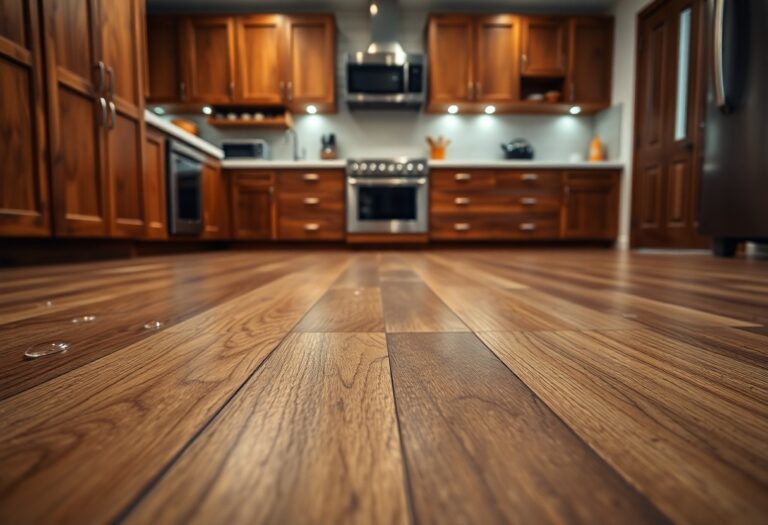Most homeowners aspire to achieve a stunning, durable flooring solution that enhances their space while standing the test of time. In this guide, you will discover imperative tips and tricks to ensure your giant flooring installation is seamless and visually appealing. From preparation to finishing touches, every step will be covered to help you make the most of your flooring project. Whether you’re a novice or a seasoned DIY enthusiast, this comprehensive resource will empower you to create the impressive results you desire.
Types of Giant Flooring
While selecting the right type of giant flooring for your space, it’s important to understand the various options available. Here’s a breakdown to help you make an informed decision:
| Type | Description |
| Hardwood Flooring | Natural wood that provides warmth and elegance. |
| Laminate Flooring | Durable and affordable alternative that mimics wood. |
| Vinyl Flooring | Water-resistant and versatile with various designs. |
| Engineered Flooring | Composed of multiple layers for stability and performance. |
| Cork Flooring | Eco-friendly option that offers comfort underfoot. |
Assume that making an informed choice will lead to a more satisfying flooring experience in your home.
Hardwood Flooring
There’s something timeless about hardwood flooring that adds sophistication to any room. Its natural grain patterns and colors bring warmth, making it suitable for various styles, from rustic to contemporary.
Laminate Flooring
Flooring can be quite versatile, especially with laminate options available today. This material consists of multiple layers, providing durability and a variety of designs that closely resemble natural wood.
Giant laminate flooring is an excellent choice if you seek an attractive appearance while keeping costs manageable. The ease of installation and maintenance makes it appealing for high-traffic areas in your home.
Vinyl Flooring
Hardwood alternatives like vinyl flooring are popular for their water resistance and easy cleanup. Available in countless styles, you can find a version that matches your interior design perfectly.
Vinyl flooring offers a practical solution for rooms that are prone to moisture, such as bathrooms and kitchens. Its durability and low maintenance requirements make it a top choice for busy households looking for functionality without sacrificing style.
Factors to Consider Before Installation
There’s a variety of elements you need to evaluate prior to installing giant flooring to ensure success. Consider the following factors:
- Your budget
- Type of flooring material
- Subfloor conditions
- Installation methods
- Future maintenance requirements
The careful consideration of these factors will lead to a more rewarding installation experience.
Room Size and Layout
Even the dimensions and configuration of your space play a significant role in your flooring choice. Larger rooms may benefit from wider planks or tiles, creating a seamless look, while irregularly shaped areas often require strategic planning to minimize waste and visual disruption. By understanding your room’s layout, you can make more informed decisions regarding cutting techniques and plank placement to achieve a polished appearance.
Climate and Moisture Levels
Little attention to the surrounding climate and humidity can lead to flooring complications, so it’s imperative to assess these conditions. Warm and humid environments may cause flooring materials to expand, while colder areas could lead to contraction. Always consider using moisture barriers or acclimating your flooring materials to the local climate prior to installation.
Room conditions greatly influence how your giant flooring performs over time. Ensuring that the humidity levels are stable and that any moisture issues are addressed can help prevent warping or buckling of the flooring. You may want to use a moisture meter to check existing levels and consult local climate data to find solutions for mitigating potential moisture issues in your installation area.

The Ultimate Guide To Giant Flooring Installation – Step-by-Step Installation Guidelines
Now you can tackle your giant flooring installation with confidence. Following these step-by-step guidelines will ensure a successful project. Use the following table to keep your installation organized:
| Step | Description |
|---|---|
| 1 | Preparation of the Subfloor |
| 2 | Installing the Flooring Panels |
| 3 | Finishing Touches |
Preparation of the Subfloor
On this stage, you need to ensure your subfloor is clean, dry, and level. Remove any debris, patches, or ridges that could interfere with the installation. A smooth surface will help the flooring panels adhere correctly, promoting durability and a professional look. Additionally, consider checking for moisture levels to prevent future warping or damage.
Installing the Flooring Panels
An effective installation of the flooring panels starts by laying them out in a staggered pattern. This technique not only enhances the aesthetic appeal but also increases the structural integrity of your installation. Ensure proper alignment and use spacers to maintain consistent gaps for expansion.
With each panel, make sure to lock them securely in place, allowing for a seamless finish. Pay attention to the manufacturer’s guidelines for cutting and fitting panels around corners and edges for a polished look. Level your installation progressively and check for any uneven areas before moving on to the next section.
Finishing Touches
Subfloor preparation may include adding trim or baseboards for a polished, completed look. After installing your flooring, consider filling gaps or applying transition strips where necessary. These small details can elevate your flooring project and ensure a professional finish that truly stands out.
To enhance the durability of your flooring, apply a sealant or protective finish if recommended by the manufacturer. This adds an extra layer of defense against everyday wear and enhances the overall appearance. Lastly, take a step back and admire the transformation you’ve achieved—your space is now a showcase of your skill and attention to detail!
Tips for a Flawless Finish
Many factors contribute to a flawless flooring installation. To ensure you achieve the best result, consider the following tips:
- Prepare the subfloor properly.
- Acclimate your flooring materials before installation.
- Use the correct adhesive or fastening method.
- Make precise measurements for cuts.
- Allow for temperature fluctuations during installation.
Thou will find that following these guidelines leads to a more professional-looking finish.
Tools and Materials Needed
With the right tools and materials at your disposal, your giant flooring installation will be more manageable and efficient. Essential items include a measuring tape, chalk line, saw (circular or miter), flooring adhesive, knee pads, and a tapping block. Don’t forget to have safety equipment such as goggles and gloves on hand to protect yourself during the installation process.
Common Mistakes to Avoid
The most common mistakes can derail your flooring project and result in a less-than-perfect finish. Make sure to double-check your measurements before cutting and to ensure the subfloor is clean and level. Avoid rushing the acclimation process, as well as skipping the use of expansion gaps that can lead to buckling over time.
Finish your giant flooring installation with care by being aware of pitfalls. For instance, failing to strike a balance between adhesive application and material expansion can lead to complications in the future. Additionally, neglecting to properly space your planks during installation may result in an uneven appearance. By staying vigilant, you can navigate these common errors and achieve the flawless finish you desire.
Pros and Cons of Giant Flooring
Not every flooring option is suitable for everyone’s needs. Below is a breakdown of the pros and cons of giant flooring to help you make an informed decision.
| Pros | Cons |
| Creates a spacious appearance | Installation can be challenging |
| Available in various materials | Can be more expensive |
| Good for large areas | Requires precise cutting and fitting |
| Fewer seams for easier maintenance | Not suitable for small, cluttered spaces |
| Enhances modern design aesthetic | May require specialized installation tools |
Advantages of Giant Flooring
Flooring options with larger dimensions can enhance the overall aesthetic of your space by providing a seamless appearance. This can make your rooms feel more open and spacious. Additionally, giant flooring is available in a variety of materials, allowing you to choose the one that best fits your style and functional needs, whether that’s wood, tile, or vinyl.
Disadvantages of Giant Flooring
There’s a potential downside to selecting giant flooring. The installation process can be more complex, requiring precision and skill to ensure a perfect fit. This can lead to increased costs, especially if you opt for professional installation. Additionally, giant flooring may not be the best choice for smaller or more cluttered spaces, as it can overwhelm the room’s proportions.
Understanding the challenges associated with giant flooring is important before you commit. You might find that it requires specialized tools and techniques during installation, which can lead to additional expenses. Moreover, the lack of seams might not be ideal for everyone, particularly if you prefer traditional flooring styles that segment spaces. Consider these factors carefully to ensure this choice suits your home and lifestyle.
Maintenance and Care for Giant Flooring
After installing your giant flooring, proper maintenance and care are necessary to ensure its longevity and aesthetic appeal. Regular attention will keep your floors looking their best and can prevent costly repairs down the line. By incorporating a few simple practices, you can protect your investment effectively.
Cleaning Tips
Clearly, keeping your giant flooring clean is vital for its upkeep. Here are some effective cleaning tips to maintain its luster:
- Use a soft-bristle broom or vacuum with a hardwood setting to remove dirt and dust.
- For spills, dab them with a soft cloth and avoid harsh cleaners.
- Apply a manufacturer-approved cleaner periodically to maintain shine.
Assume that regular cleaning will extend the lifespan of your flooring and enhance its overall appearance.
Long-term Care Recommendations
Some care tips are necessary for maintaining the beauty and functionality of your giant flooring over the years. Consistent care will help you avoid wear and tear, ensuring that your floors stay in top condition.
It is advisable to place rugs in high-traffic areas to prevent scratches and dents. Additionally, ensure you use furniture pads under all legs to minimize indentations. Regularly checking for moisture and humidity can help you avoid warping. As time passes, consider refinishing your flooring every few years to restore its original sheen, thus enhancing its durability and aesthetics. Being proactive in your maintenance will preserve the charm of your giant flooring for years to come.
Conclusion
Hence, with the insights and techniques provided in this ultimate guide to giant flooring installation, you are well-equipped to achieve a flawless finish in your project. By focusing on preparation, precise measurement, and careful execution, you can ensure that your flooring not only enhances the aesthetic appeal of your space but also stands the test of time. Embrace these tips and tricks, and take pride in the beautiful results you create with your own hands.





